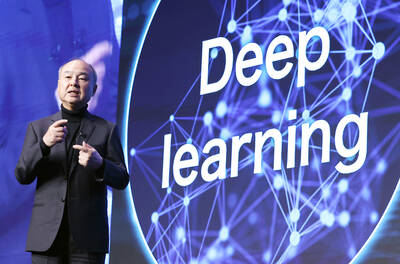Intel Corp on Tuesday said that losses have deepened at its chip manufacturing operations and the business might not break even for several years.
Intel Foundry, a new division of the company responsible for manufacturing, had sales of US$18.9 billion last year, down from US$27.5 billion the previous year, Intel Corp said.
The operating loss at the new unit widened to US$7 billion from US$5.2 billion.

Photo: Reuters
Intel Corp is giving a more detailed picture of its finances as part of an ambitious turnaround plan by chief executive officer Pat Gelsinger.
He is breaking out the results from the factory network as a step toward having it operate more independently. The business is seeking to make chips for other companies, and giving it some separation from the rest of Intel is vital to that strategy.
“We believe this transparency and accountability is needed,” Gelsinger said during a presentation. “The required transformation is well under way.”
The company expects this year to be the peak of its losses and that Intel Foundry would be profitable, on an operating level, “midway between now and the end of 2030,” he said.
The chipmaker also named Lorenzo Flores as chief financial officer of the division.
Intel’s push into outsourced chip production — known as the foundry industry — is one of the company’s biggest transformations in its history. Gelsinger’s comeback effort also includes restoring Intel Corp’s once-unassailable technology edge — something that the chip pioneer lost in the years before he took the reins in 2021 — by next year.
That would improve the capabilities of Intel’s products and make them cheaper to manufacture. It would also allow the company to win orders from competitors, something that would provide as much as US$15 billion in sales by the end of 2030, he said.
Intel said there are five such companies committed to using its latest production technique, called 18A.
It is to become more widely used starting next year and gather momentum after that, the company said.
Taiwan Semiconductor Manufacturing Co (台積電) dominates the foundry market and has eclipsed Intel in overall revenue. It posted sales of US$69.4 billion, net income of US$26.9 billion and gross margin of 54 percent last year. Sales this year are projected to expand 20 percent to US$83.4 billion.
Intel has embarked on a record-setting expansion of its factories in the US and Europe, taking advantage of government incentives such as the US’ CHIPS and Science Act.
However, even with that support, it is an expensive undertaking that has put investors on edge.
Intel Corp chief financial officer Dave Zinsner, who joined Gelsinger in taking questions from analysts on Tuesday, acknowledged that there is plenty of room for improvement.
However, separating out the manufacturing group — and treating the company’s product division as a customer — has already yielded benefits, Zinsner said.
There has been a huge reduction in expensive requests for expedited work and test chips, he said.

IN THE AIR: While most companies said they were committed to North American operations, some added that production and costs would depend on the outcome of a US trade probe Leading local contract electronics makers Wistron Corp (緯創), Quanta Computer Inc (廣達), Inventec Corp (英業達) and Compal Electronics Inc (仁寶) are to maintain their North American expansion plans, despite Washington’s 20 percent tariff on Taiwanese goods. Wistron said it has long maintained a presence in the US, while distributing production across Taiwan, North America, Southeast Asia and Europe. The company is in talks with customers to align capacity with their site preferences, a company official told the Taipei Times by telephone on Friday. The company is still in talks with clients over who would bear the tariff costs, with the outcome pending further

A proposed 100 percent tariff on chip imports announced by US President Donald Trump could shift more of Taiwan’s semiconductor production overseas, a Taiwan Institute of Economic Research (TIER) researcher said yesterday. Trump’s tariff policy will accelerate the global semiconductor industry’s pace to establish roots in the US, leading to higher supply chain costs and ultimately raising prices of consumer electronics and creating uncertainty for future market demand, Arisa Liu (劉佩真) at the institute’s Taiwan Industry Economics Database said in a telephone interview. Trump’s move signals his intention to "restore the glory of the US semiconductor industry," Liu noted, saying that

STILL UNCLEAR: Several aspects of the policy still need to be clarified, such as whether the exemptions would expand to related products, PwC Taiwan warned The TAIEX surged yesterday, led by gains in Taiwan Semiconductor Manufacturing Co (TSMC, 台積電), after US President Donald Trump announced a sweeping 100 percent tariff on imported semiconductors — while exempting companies operating or building plants in the US, which includes TSMC. The benchmark index jumped 556.41 points, or 2.37 percent, to close at 24,003.77, breaching the 24,000-point level and hitting its highest close this year, Taiwan Stock Exchange (TWSE) data showed. TSMC rose NT$55, or 4.89 percent, to close at a record NT$1,180, as the company is already investing heavily in a multibillion-dollar plant in Arizona that led investors to assume

AI: Softbank’s stake increases in Nvidia and TSMC reflect Masayoshi Son’s effort to gain a foothold in key nodes of the AI value chain, from chip design to data infrastructure Softbank Group Corp is building up stakes in Nvidia Corp and Taiwan Semiconductor Manufacturing Co (TSMC, 台積電), the latest reflection of founder Masayoshi Son’s focus on the tools and hardware underpinning artificial intelligence (AI). The Japanese technology investor raised its stake in Nvidia to about US$3 billion by the end of March, up from US$1 billion in the prior quarter, regulatory filings showed. It bought about US$330 million worth of TSMC shares and US$170 million in Oracle Corp, they showed. Softbank’s signature Vision Fund has also monetized almost US$2 billion of public and private assets in the first half of this year,